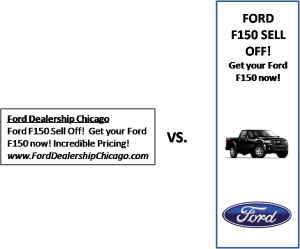Banner ads or Pay Per Click (PPC) advertising?
With over 220 Million internet users or 74% of the population in the United States alone, Automotive Dealers have increasingly sought out online advertising. The question that I frequently get from dealers is what should I focus on Banner ads or Pay Per Click (PPC) advertising?
Since I received this question so often from my automotive dealers, I thought I would post some information about the difference between the two. What they are, how they differ, etc. Hopefully this will allow you to make the decision on which one to use or evaluate where to spend more of your budget.
What is Banner Advertising?
Banner advertising is simply the process of purchasing banner space on other websites for you to display a banner about the product or service you wish to advertise.
There are millions of websites to choose from when placing a banner advertisement. You should ultimately consider the website’s: traffic, page views, impressions, demographics, the CPM (cost per thousand impressions), monthly fee or CPA (cost per action).
The easiest comparison to a banner ad on a website would be a billboard. When considering a billboard, would you choose the busiest highway where your billboard will receive plenty of unique viewers or a side street? The more traffic on a highway would drive more unique users seeing your billboard, which is ideally what you want. You would also pay more for that premium ad space.
You can either do the research yourself, by identifying the right websites to make banner ad placements on, or you can advertise through an ad network which have a network of websites who will publish your banner ad on their sites. Utilizing a network can be more cost effective and it allows you to have a larger audience because of the number of websites on which these ad networks place you.
What is Pay Per Click (PPC) advertising?
PPC is the process of advertising on search engines such as Google, Yahoo and Bing within the sponsored results. Google is the #1 site in the United States and as of today has 65% of the Search share, so I’ll focus on Google.
Google AdWords allows you two different advertising options, Search Network or the Content Network – I’m going to discuss the Search Network because it typically delivers the best conversions.
On Google’s Search Network, you bid on a keyword and your ad will appear higher or lower within the results based on bid price and quality score.
The nice thing about Google’s Search Network is your ad appears only when a keyword you are bidding on is searched within the market area parameters you set. It’s extremely targeted. The difference is your ad is in text format as opposed to a banner advertisement. And of course, you only get billed by Google if someone clicks your ad, hence pay per click, and you only pay the amount you’re bidding.
What is similar for both banner ads and pay per click ads is that, when the viewer clicks the ad, the viewer/clicker is taken to your website. Both of these forms of advertising are designed to drive traffic to your website.
The biggest difference between these two forms of advertising is the PPC ads only appear when a search engine user types in specific keywords, presenting itself only when there is a demand. So if you’re a Toyota dealer and someone types in “Toyota Camry,” your ad would appear within the sponsored results. With banner advertising, it’s not always that easy. Although there are behavioral targeting formats to banner advertising, your ad is going to show up for users that may not be interested in your product.
This might lead one to quickly believe that PPC advertising would then be more effective than banner ads, but banner ads can actually serve a different purpose. Banner ads can work well for branding purposes with higher volume websites. While it’ is not as targeted as a pay per click, the banner ad may be served to someone who is in the research phase of the car buying process.
Banner advertising is more appropriate if your goal is to brand because banner advertising will not deliver as high of a conversion percentage (meaning submitting an lead form or phone call) as delivered by pay per click ads.
At the end of the day, any automotive dealership owner is after one thing, return of investment. The medium that delivers that ROI is going to be the best medium to use in advertising your automotive dealership.
Automotive PPC

Automotive PPC vs Banner Advertising
